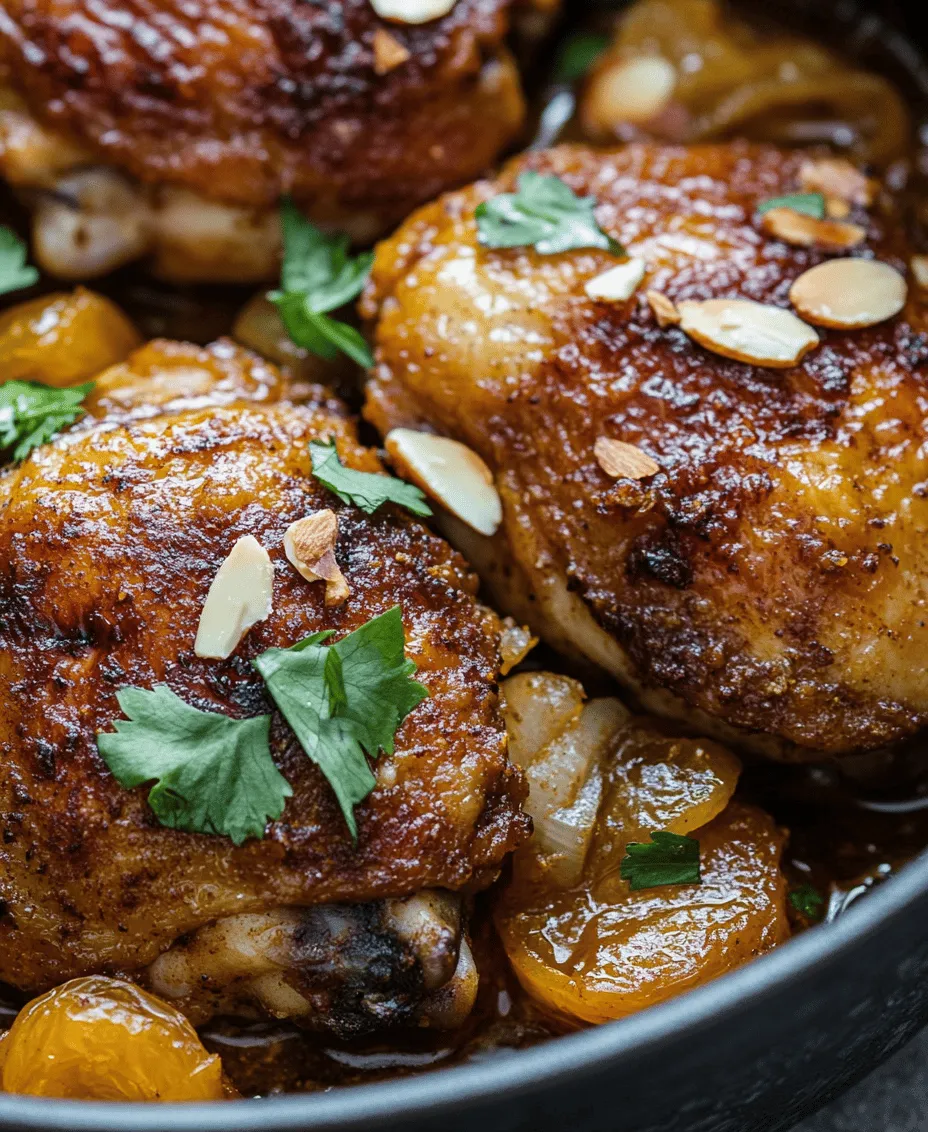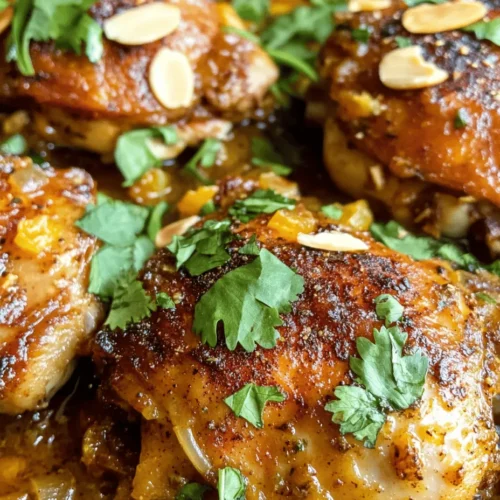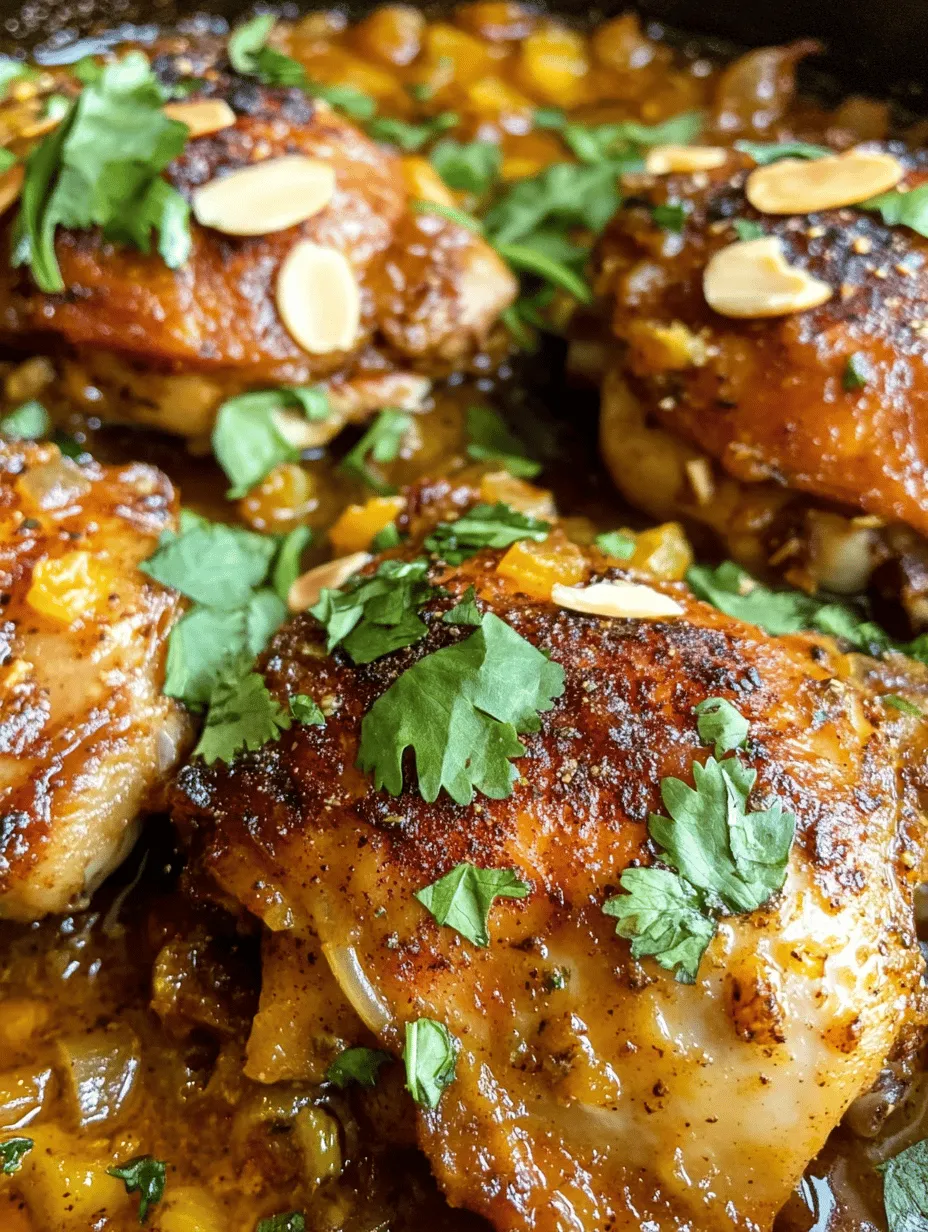Introduction
Moroccan cuisine is a vibrant tapestry of flavors and aromas, drawing from a rich cultural heritage that blends the influences of Berber, Arab, and Mediterranean culinary traditions. This North African culinary style is renowned for its use of aromatic spices, fresh ingredients, and the harmonious balance of sweet and savory elements. Among the standout dishes that exemplify this unique flavor profile is Moroccan Spiced Chicken. This dish features succulent chicken pieces marinated in a symphony of spices, creating a culinary experience that is both exotic and comforting.
The beauty of Moroccan Spiced Chicken lies not only in its exquisite taste but also in its ease of preparation. It is a versatile dish that can transform a simple family dinner into a festive occasion or impress guests at a special gathering. The aromatic spices infuse the chicken with unparalleled flavor while the cooking process ensures that every bite is juicy and tender. Whether served over a bed of fluffy couscous or alongside roasted vegetables, this dish is sure to become a favorite in your cooking repertoire.
Understanding the Ingredients
To create the perfect Moroccan Spiced Chicken, it is essential to understand the primary ingredients that contribute to its distinctive flavor. Each component plays a crucial role in building the dish’s overall profile, from the choice of chicken to the selection of spices.
Chicken Thighs
When it comes to choosing the right cut of chicken for this recipe, bone-in, skin-on chicken thighs are the preferred option. This choice is not merely about tradition; it has practical benefits that enhance the dish’s flavor and texture. The bone helps retain moisture during cooking, resulting in tender, juicy meat. The skin, when properly seared, becomes deliciously crispy, adding a delightful contrast to the tender chicken underneath. Additionally, chicken thighs have a richer flavor compared to breast meat, making them ideal for absorbing the spices in the marinade.
The Spice Blend
The heart of Moroccan Spiced Chicken lies in its vibrant spice blend, which is a hallmark of Moroccan cooking. Here’s a closer look at the spices that make this dish extraordinary:
– Ground Cumin and Coriander: These spices are fundamental in Moroccan cuisine, offering a warm, earthy flavor. Cumin, with its nutty and slightly peppery notes, provides depth, while coriander adds a subtle citrusy brightness. Both spices have origins in ancient culinary traditions and are celebrated for their health benefits.
– Ground Cinnamon and Ginger: Cinnamon is often associated with sweet dishes, but in Moroccan cooking, it finds a place in savory recipes as well. Its warmth complements the spices beautifully. Ginger, on the other hand, brings a hint of spice and freshness, enhancing the overall flavor profile of the dish.
– Paprika and Cayenne Pepper: Paprika adds a mild sweetness and vibrant red color to the marinade, while cayenne pepper introduces a touch of heat. The balance of these flavors is essential, allowing for a dish that is flavorful without being overwhelmingly spicy.
Fresh Ingredients
In addition to the spice blend, fresh ingredients play a pivotal role in elevating the dish. Garlic and onion provide a savory and aromatic base, while lemon adds acidity and brightness, cutting through the richness of the chicken. The use of fresh ingredients not only enhances flavor but also contributes to the dish’s overall freshness and appeal.
Dried Apricots
A unique aspect of Moroccan Spiced Chicken is the inclusion of dried apricots. These sweet morsels not only add a delightful contrast to the savory spices but also introduce a chewy texture that complements the tender chicken. The sweetness of the apricots balances the heat from the spices, creating an unforgettable flavor experience.
Garnishes
Finally, garnishes such as slivered almonds and fresh cilantro play an important role in the presentation and flavor of the dish. The crunch of the almonds adds texture, while cilantro brings a fresh, herbaceous note that brightens the overall dish. These finishing touches not only enhance the visual appeal but also contribute to the complex layering of flavors that define Moroccan cuisine.
Preparation Steps
Now that we have a comprehensive understanding of the ingredients, it’s time to delve into the preparation steps that will guide you in creating this mouthwatering Moroccan Spiced Chicken.
Marination Process
The first step in preparing Moroccan Spiced Chicken is marination, which is essential for infusing the chicken with flavor. Marinating allows the spices to penetrate the meat, resulting in a dish that is bursting with taste.
1. Create the Marinade: In a bowl, combine the ground cumin, coriander, cinnamon, ginger, paprika, cayenne pepper, minced garlic, and finely chopped onion. Add the juice of one lemon and a few tablespoons of olive oil to create a paste-like consistency. Mix well to ensure that all the spices are evenly distributed.
2. Prepare the Chicken: Pat the chicken thighs dry with paper towels to remove excess moisture. This step is crucial for achieving crispy skin during cooking. Place the chicken in a large resealable plastic bag or a shallow dish.
3. Marinate: Pour the prepared spice mixture over the chicken, ensuring that each piece is thoroughly coated. Seal the bag or cover the dish with plastic wrap and refrigerate. For optimal flavor, marinate for at least 2 hours, but if time allows, overnight marination is ideal. This longer marination allows the spices to fully permeate the meat.
Searing the Chicken
Once the chicken has marinated, it’s time to sear it, which enhances the flavor and texture. Here’s how to do it effectively:
1. Preheat the Pan: Heat a large skillet or cast-iron pan over medium-high heat. Add a drizzle of olive oil and allow it to heat until shimmering.
2. Sear the Chicken: Carefully place the marinated chicken thighs skin-side down in the hot pan. Avoid overcrowding the pan, as this can lead to steaming rather than searing. Cook for about 5-7 minutes or until the skin is golden brown and crispy.
3. Manage the Heat: Pay attention to the heat during the cooking process. If the pan becomes too hot, lower the heat slightly to prevent burning. You want to achieve a deep golden brown color without charring.
4. Flip and Finish Cooking: Once the skin is crispy, flip the chicken thighs and cook for an additional 5-7 minutes on the other side. At this point, you can add the dried apricots to the pan, allowing them to warm and infuse their sweetness into the dish.
5. Check for Doneness: To ensure the chicken is fully cooked, use a meat thermometer to check that the internal temperature has reached 165°F (75°C). This step is crucial for food safety, especially when working with poultry.
By following these preparation steps, you’ll be well on your way to creating a delectable Moroccan Spiced Chicken dish that tantalizes the taste buds. Stay tuned for the next section, where we will explore additional cooking techniques and tips for serving this flavorful recipe at its best.

Sautéing Onions: The Importance of Developing Flavor Through Sautéing
One of the most critical steps in creating a memorable Moroccan Spiced Chicken is the sautéing of onions. This process serves several purposes in developing the dish’s overall flavor profile. When onions are sautéed, they release their natural sugars, which caramelize and enhance their sweetness. This sweetness balances the spices used in the chicken marinade, creating a well-rounded flavor.
To sauté onions effectively, begin by heating a generous amount of olive oil in a large, heavy-bottomed skillet or Dutch oven over medium heat. Add finely chopped onions and a pinch of salt, stirring occasionally. The key is to allow the onions to soften and become translucent, which typically takes about 5-7 minutes. You want them to be fragrant and lightly golden, not browned. This step lays the foundation for a rich, aromatic base that will elevate the entire dish.
Incorporating the Broth and Apricots: Creating a Rich Sauce
Once your onions are perfectly sautéed, it’s time to build upon that flavor. Add your seasoned chicken pieces to the skillet, allowing them to brown slightly on all sides. After the chicken is nicely seared, pour in the chicken broth and add dried apricots. The broth creates a luscious sauce, while the apricots introduce a delightful sweetness that complements the spices.
As the dish simmers, the apricots will soften, infusing the broth with their fruity essence. This combination of savory and sweet is a hallmark of Moroccan cuisine, making it both intriguing and comforting. Allow the mixture to come to a gentle boil, then reduce the heat to low, covering the pot to retain moisture as it simmers.
Baking Process: Importance of Cooking Temperature and Time
After the initial sautéing and simmering, transfer the chicken and sauce to a preheated oven set at 375°F (190°C). Baking the chicken allows the flavors to meld beautifully while ensuring that the meat remains tender and juicy. Generally, the chicken should bake for about 25 to 30 minutes, but the actual time may vary based on the size of the chicken pieces.
To ensure that your Moroccan Spiced Chicken is cooked to perfection, it’s essential to check for doneness. The internal temperature of the chicken should reach 165°F (74°C). A meat thermometer is a reliable tool for this purpose. Alternatively, you can check for doneness by cutting into the thickest part of the chicken; the juices should run clear, and the meat should no longer be pink.
Serving Suggestions: Ideal Side Dishes to Accompany Moroccan Spiced Chicken
With your Moroccan Spiced Chicken coming out of the oven, it’s time to think about the perfect accompaniments. The right side dishes can enhance the meal, making it an unforgettable experience.
1. Couscous: This North African staple is light and fluffy, making it an ideal pairing with Moroccan Spiced Chicken. The grains absorb the rich sauce beautifully, allowing for a delightful textural contrast. To prepare, simply steam couscous and fluff it with a fork before serving.
2. Steamed Rice: For those who prefer a comforting option, steamed rice works wonders. Whether you opt for jasmine, basmati, or even brown rice, the neutral flavor of rice complements the complex spices of the chicken, providing a satisfying base.
3. Crusty Bread: There’s something utterly comforting about a loaf of warm, crusty bread. It’s perfect for soaking up the flavorful sauce from the chicken. A freshly baked baguette or rustic country bread can transform your meal into a communal experience, inviting everyone to dig in and share.
Presentation Ideas: How to Serve the Dish Attractively
Presentation can elevate your Moroccan Spiced Chicken from a simple dinner to a feast for the eyes. Consider serving the dish in a large, colorful tagine or a shallow serving platter. Garnish with freshly chopped cilantro or parsley for a pop of color and freshness.
Add some sliced lemons and a sprinkle of toasted almonds on top for an extra layer of flavor and texture. For an authentic touch, serve alongside traditional Moroccan tea in decorative glasses, completing the experience.
Cultural Significance of Moroccan Cuisine
Moroccan cuisine is a rich tapestry woven from various cultural influences, including Berber, Arab, and Mediterranean traditions. Each region of Morocco boasts unique culinary practices and ingredients, reflecting the country’s diverse history and geography. Spices play a crucial role in Moroccan cooking; they are not merely flavor enhancers but also symbols of hospitality and warmth.
Communal eating is a cornerstone of Moroccan culture. Meals are often shared with family and friends, served in large platters from which everyone helps themselves. This practice fosters connection and conversation, making dining an integral part of Moroccan life.
Nutritional Insights: Overview of the Nutritional Benefits of the Main Ingredients
Moroccan Spiced Chicken is not just delicious; it’s also packed with nutritional benefits. Chicken is an excellent source of lean protein, which is essential for muscle growth and repair. The inclusion of spices like cumin, coriander, and cinnamon offers various health benefits, from anti-inflammatory properties to improved digestion.
The addition of apricots provides a dose of natural sweetness along with dietary fiber, vitamins A and C, and antioxidants. These ingredients collectively contribute to a balanced meal that can fit into a healthy diet. For those with dietary concerns, this recipe is naturally gluten-free and high in protein, making it suitable for various dietary preferences.
Conclusion: Embracing the Culinary Traditions of Morocco
Moroccan Spiced Chicken is more than just a meal; it’s a celebration of flavors, culture, and togetherness. The combination of aromatic spices, tender chicken, and the sweet-and-savory sauce creates a dish that is both comforting and exotic.
We encourage you to try making this flavorful recipe at home, embracing the culinary traditions of Morocco. The joy of cooking and sharing meals with loved ones is at the heart of this dish, inviting you to create connections through food. As you explore the rich flavors of Moroccan cuisine, remember that each bite tells a story—a story of history, culture, and the love that goes into every meal.



